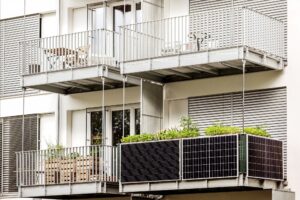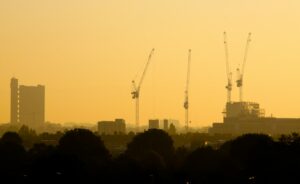Martin Guttridge-Hewitt speaks to Duncan Mounsor, Managing Director at Enviro Technology Services, to learn about advancements in air monitoring technology of the last 30 years, and the most important policy changes to clean up Britain’s atmosphere.
‘You’ve probably heard of Moore’s Law, which basically says microprocessors double in power with each generation. A similar principle applies to semiconductor components in electronics,’ Duncan Mounsor tells Air Quality News.
As Managing Director of Enviro Technology Services, he’s well placed to comment. Joining the air quality measurement specialist 33 years ago, he’s observed a lot of change in the sector since 1990. Not least the forward march of tech.
‘There’s been a huge movement towards laser based and optical technology, which is where it’s all happening right now for measuring gaseous molecules and particulates. These systems just weren’t available 30 years ago, and the technologies have not only evolved in that time, but become cheaper – especially in terms of the type of lasers you need for measuring gases,’ he explains.
‘People have figured out that you can use lasers to measure all different types of gases, and to look for particles,’ Mounsor says. ‘ Today the equipment is usually much faster and more precise than when I started out… generally, they’re getting smaller, lighter, have less requirements, and don’t use as much power as they did.’
There’s plenty of evidence to support the positive impact advancements have had on the UK’s air pollution, too. When asked how he feels the country has done in terms of working towards a cleaner atmosphere, we’re quickly told that progress has been ‘absolutely fantastic’. Moving away from old coal-fired power stations has had a huge impact. As has investing renewable energy sources, and introducing legislation to take the dirtiest vehicles off the road. It’s unlikely much of this would have happened without effective measurement infrastructure.
‘But the issue hasn’t gone away. The UK’s biggest urban air pollution problem is still vehicle emissions and transport. So, you know, there’s this big push to electric and hybrids, but there are still so many petrol and diesel vehicles out there. Each one carries a combustion power source, each produces air pollution. So, yes, things have got better, especially from an industrial perspective… [but] at least 50,000 people die prematurely each year because of their air they breath. And that’s the UK – a top 10 global economy,’ says Mounsor.
‘Often it’s the most disadvantaged people impacted most. Those at the lower income levels,’ he continues. ‘They can’t choose where to live, whereas many of us would try to move if air pollution was a problem. Unfortunately, a lot of people can’t, and end up spending most of their lives in areas where pollution levels are high and this has a big effect on their health,’ he says, citing the tragic case of Ella Adoo Kissi-Debrah, the ten-year-old who became the first person in Britain to have air pollution listed as a cause of death.
If technology is leading the march to clean up pollution, policy often lags behind. A decade after the shock of a child dying due to dirty air, the UK still hasn’t fully ratified the Clean Air (Human Rights) Bill, also known as Ella’s Law. And, while international climate agreements and domestic energy and economic pressures are catalysing progress in many ‘green areas’, this often feels too slow and piecemeal. We ask for Mounsor’s thoughts on reforms that could speed things up.
‘People are more aware of air pollution than ever, but that’s still a big issue – the majority won’t even give the air they breathe a second thought,’ he replies. ‘Air pollution is invisible, you can’t taste it or smell it usually. It’s up to local authorities, and the Government, to actually make sure monitoring stations are capable of confirming to us that what we’re breathing is OK. If not, there’s a statutory duty, a responsibility, to clean things up.
‘That’s the hard part, because obviously we have this big behavioural change, a shift needed to get people less dependent on cars,’ he continues. ‘I think the fundamental thing really is to be measuring properly. A lot of times in the UK, we’re reliant on computer modelling to advise on how clean the air is. That’s basically an educated guess based on the quality of information going into the models. Sometimes they’re right, sometimes they’re wrong. We believe more real time monitoring should be done, especially in problem areas.’
Despite this warning, Mounsor is quick to point out that things are heading in the right direction. His company works alongside councils, regulators, government departments and more, helping them upgrade and expand monitoring networks. As he explains, a number are already invested in technology that will still be fit for purpose in the 2030s. And more monitoring stations have also been established, increasing reach and improving access to that data.
‘It can be a very conservative business, air quality monitoring – technologies used to measure nitrogen oxides (NOx) and particulates have been around for many years… So we see it as our role to be looking at the horizon, scanning for the new technologies that are having real impact, then bringing these to the UK market,’ he tells us, before explaining Enviro Technology Services is also now at the forefront of ‘the circular idea’ Simply put, tackling climate change, pollution, biodiversity loss and other environmental challenges need collaboration and shared knowledge.
‘In 2023, Enviro Technology Services celebrates its 40th anniversary. And after almost 40 years as a privately owned, independent company, we were acquired by an exciting and relatively new firm, Cura Terrae,’ says Mounsor. ‘The group is already involved in water and waste water monitoring through a company called EMS, they test industrial stack emissions under the Envirocare brand, and there’s an environmental consultancy service for habitats and ecology – Ecus Ltd. So adding air pollution to these arms brings everything together as a whole, covering all bases.’
Images: Enviro Technology Services


















More measurement of air quality in rural towns would be a start. They are being totally neglected.
Excellent, Martin, thank you. Less modelling and more measuring, we couldn’t agree more! There are very many rural areas of the UK, especially small towns with plenty of traffic and other kinds of air pollution where absolutely no air quality monitoring is going on, at least not by the local councils or our government. Where ‘citizen science’ is at work, i.e. ordinary people with their own air pollution meters, the levels can be seen for what they are, and not dismissed as nothing to worry about. If the air quality is not assessed, how can anyone say? We firmly believe that enough real-time measurements are being made, which means the official Defra-based networks need expansion and as you have outlined here the ways and means to do this now exist. However, is there a problem if it is private companies and individuals who undertake the air quality monitoring? Will our local authorities believe us when we say the air is really not so good where we, or others, live? And if they do agree, will this lead to genuine improvements, or just the usual vague talk about meetings to plan other meetings?
Indeed, more monitoring and less modelling would be welcome. Duncan Mounsor refers to the ” statutory duty, a responsibility, to clean things up” on the local authority. But how do we ensure that the local authority carry out that statutory duty? Clearly, the Covid restrictions impacted on the work of local authorities. But these restrictions are long gone, for the most part.I live in a designated smoke control area, under the Clean Air Act. Yet my local authority refuse to enforce the act. I have a issue with a nearby woodburner frequently producing pollution.The attending officers refuse to acknowledge the Act, don’t have Ringelmann charts (in fact, they apparently don’t know what they are). don’t understand when I refer to particulates (what are they?), and simply say in their opinion it’s wood which is an authorised fuel. They take no notes or recordings, refuse to treat it as a nuisance under the old EPA (Scotland does not yet have the new EPA).
The attached image is typical . I have tried to engage with my local authority and asked to have the officers visits reviewed. The authority refuse to view any media; and refuse to review their officers’ reports. I am sure that I am not alone. Can I take legal action to force my authority to review their officers’ actions ?